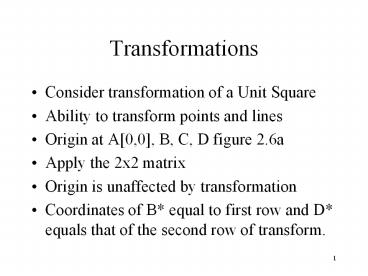Transformations - PowerPoint PPT Presentation
1 / 19
Title:
Transformations
Description:
1. Transformations. Consider transformation of a Unit Square. Ability to ... S produces overall scaling s 1 enlargement scaling or s 1 reduction scaling. 14 ... – PowerPoint PPT presentation
Number of Views:70
Avg rating:3.0/5.0
Title: Transformations
1
Transformations
- Consider transformation of a Unit Square
- Ability to transform points and lines
- Origin at A0,0, B, C, D figure 2.6a
- Apply the 2x2 matrix
- Origin is unaffected by transformation
- Coordinates of B equal to first row and D
equals that of the second row of transform.
2
Unit Square Tranformation
- B and D determine the 2D transform
- Transformed figure is a parallelogram ( recall
that parallel lines transform as parallel lines) - Combination of shearing ( b and c terms) and
scaling (a and d terms) - Area property is of special interest why?
3
Area properties
- Ap area of big rectangle area of triangles(2)
area of polygons(2) - Area as function of determinant of the
transformation matrix - Ap As(ad bc) As area of initial square
- Generalisation as At Ai(ad bc)
- Area of arbitrary shapes in 2D
4
Arbitrary rotation
- Pure rotation of a unit square
- Consider rotation about the origin (fig 2.7)
- Positive rotation in the CCW direction
- Point B to B with x (1)cos _at_ and y
(1) sin _at_ - Point D to D with x -(1) sin _at_ and y
(1) cos _at_ - Point B and D define the arbitrary matrix
5
2x2 Rotation matrix
- Roation matrix is defined as
- cos _at_ sin _at_
- -sin _at_ cos _at_
- For 90 degree CCW rotation about the origin this
reduces to 0 1 - -1 0
- Scaling and Shearing with no dimension change
hence a pure rotation matrix ( _at_ )
6
Translations
- We have not introduced any translations
- Forrest (2-2) introduced third component to
point vectors to overcome this - x y 1 and x y 1
- The 3x3 transformation is introduced as follows
1 0 0 - 0 1 0
- m n 1
7
Homogeneous Coordinates
- x y 1 is now the transformed vector
- Addition of third element to position vector
- Addition of third column/row to transformation
matrix - Look at this as an additional coordinate of the
position vector - x y 1 becomes X Y H
8
Homogeneous Coordinates
- Transformation to the plane H 1
- If the transformation is 1 0 p
- 0 1
q - m n
s - X Y H where H is not equal to 1
- Coming back to 2D, we restrict H 1
- x y X/H Y/H 1
9
Homogeneous Coordinates
- Representation of a n-component vector by an n1
component vector is called homogeneous coordinate
representation - Do transformation in n1 space and project back
to the n-dimensional space of interest (H 1 in
our case) - Physical coordinates are x hx/h and yhy/y
10
Uniqueness
- No unique homogeneous representation of a point
in 2-space - For example 12 8 4, 6 4 2 and 3
2 1 all represent the physical coordinates of
3 2 - In homogeneous coordinates X Y H x y 1
- a b 0
- c d 0
- 0 0 1
11
Normalization
- All transforms of x and y fall within the plane
of H1 after normalization - Translation and projection could now be
introduced - Scaling and shearing using a, b, c, d
- What is projection? x y (pxqy1) . See
eq.2-34. Page 39)
12
Projection
- H px qy 1 defines the plane containing
homogeneous coordinates - Figure 2-9. AB to CD and back to C D
- Effect of normalizing is to project CD to C D
letting H 1 using origin as center of
projection - Four parts of a 3x3 transformation matrix
13
3x3 TRANSFORM
- A,B,C,D produce scaling, shear and rotation
(see page 40) - M and N produce translation
- P and Q produce projection
- S produces overall scaling s lt 1 enlargement
scaling or s gt 1 reduction scaling
14
Points at infinity
- Homogeneous coordinates will allow mapping one
set of points to map from one coordinate system
to another. - Infinite to finite range
- x y 0 in 2-dimensions represents points at
infinity - Generalized transformation is of more practial
use in CAE
15
ARBITRARY AXIS ROTATION
- Rotations about points other than origin is now
possible - 3 step process to accomplish arbitrary point
rotations - - Translate to the origin from given point
- - Apply rotation transformation
- - Translate back to the given point
16
ROTATION ABOUT POINT
- Get disired center of rotation to the origin
(usually negate coordinates page 44) - Apply rotation matrix to rotate about origin
- Reverse translation back to the point
- 2D rotations about each axis are given in figure
2-10. Operators and diagrams.
17
- Scaling is controlled by the magnitude of the two
terms in the primary DIAGONAL of the T matrix - Using 2 0
- 0 2 a 2 times magnification about
origin occurs - Unequal scale factors create distorsion
- Plane surfaces can be easily transformed
18
Combined Transformations
- Typically more than one transform used
- Controls shape and position
- NON-COMMUTATIVE
- Order is important in matrix multiplications
- Consider a 90-degree rotation and then reflection
on one of the vertices x y of a triangle
19
Combined Transformations
- First rotate and then apply reflection
- Result y x
- Now first apply reflection and then rotate
- Result -y -x
- NOT THE SAME. NON-COMMUTATIVE
- Mapping from one plane into a second plane































